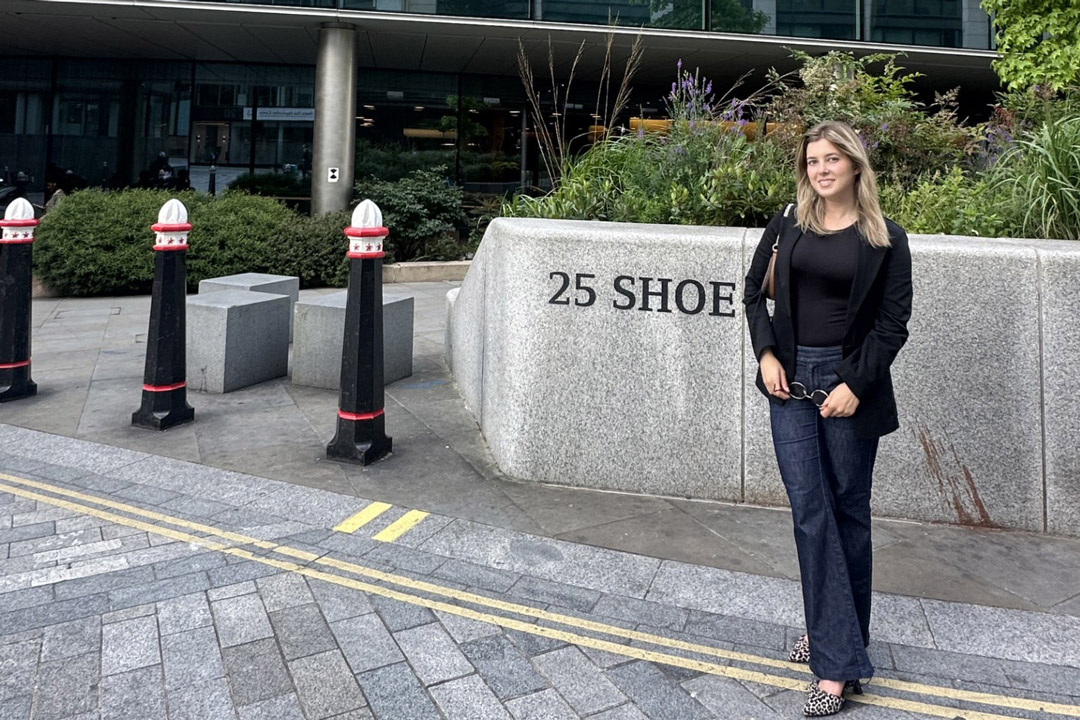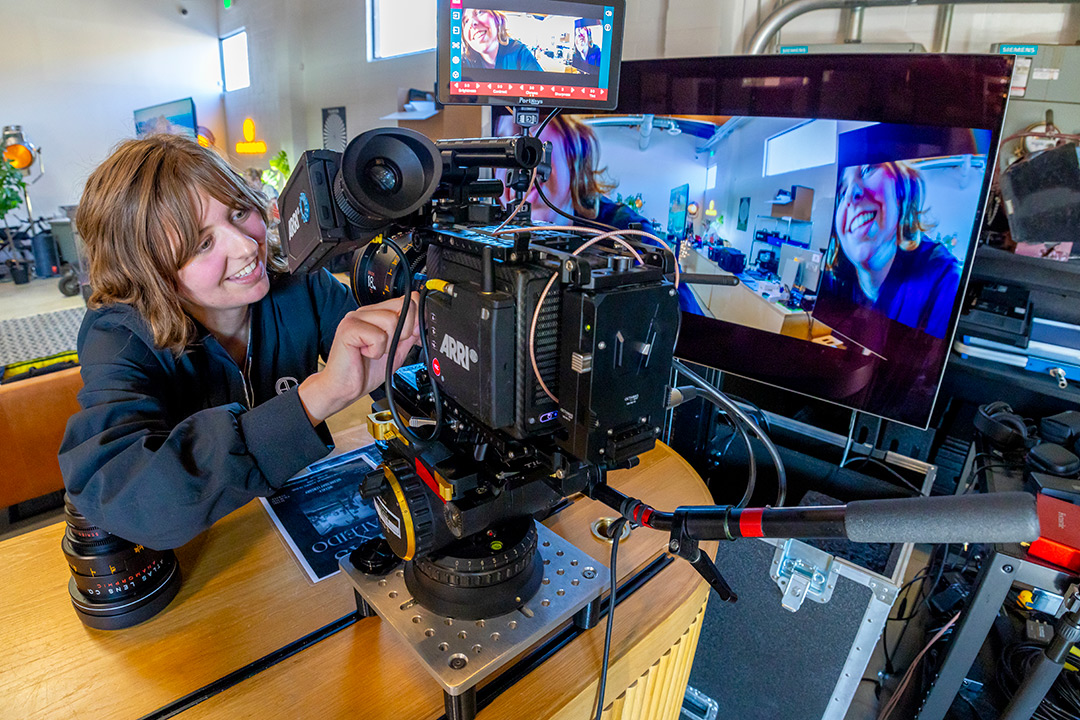Global scholars gain international professional and personal experiences
Natali Belusic wanted to learn about business while having the opportunity to be immersed in an English-language environment. RIT Croatia was the perfect choice to achieve that, and it opened the doors for international learning and experience. After landing a summer internship at Goldman Sachs in London, Belusic is now studying on RIT’s main campus in Rochester as part of the global scholars program. Global campuses RIT has global campuses in Dubai, Croatia, and Kosovo. Learn more about degree programs offered at each campus and how to study abroad at a global campus.
The global scholars program brings students from RIT’s international campuses to study for up to two terms at the Rochester campus. The experience gives students a chance to diversify their cultural perspectives, expand their academic horizons, and build their professional networks. The program, in its 15th year, welcomed its largest group of 77 students this fall. When it began in the 2010-2011 academic year, there were just six global scholars. Alumni of the program have gone on to successful careers. One former student helped build a system for the International Space Station then went on to Columbia University to pursue a master’s degree. Another is the curator of the National Gallery of Kosovo. Others work for companies including TikTok, Coca-Cola, and Amazon. Belusic is studying international business. She already gained valuable real-world experience while interning at Goldman Sachs’ risk division for nine weeks. While she didn’t think she would get the internship because of how selective and competitive it is, she felt well-prepared when applying. “RIT helped me prepare for the internship in terms of courses that I had and helped me shape my résumé and cover letter, give me knowledge on how to approach interviews, and network, as well,” she said. Now Belusic is using her time in the U.S. to broaden her academic and professional portfolio before graduating this spring. Then she will begin a full-time role back at Goldman Sachs in London next summer. “I decided to take the opportunity of additional courses and resources here that are not offered in Croatia,” said Belusic. “For example, the Bloomberg terminals that we can use and social perspective classes gave me benefits for my academic journey.” Another opportunity Belusic had while studying in the U.S. was to publish a research paper with one of her professors from Croatia. She did this through the honors program with the International Conference on Business, Management, Economics, and Information Systems hosted by The City University of New York. Experiences like Belusic’s are what make the global scholars program and RIT’s international connections a benefit for students.The program gives international students the chance to complete minors and participate in research projects that may not be offered at their home campuses. These benefits lead to impressive career opportunities. While Belusic has always been interested in working abroad, it may seem daunting for some students to travel and study in a different country. However, Belusic explained that going to a new place with a new environment helps a person learn more about themselves and how they handle different situations. “Study-abroad experiences have always exceeded my expectations,” said Belusic. “There are so many reasons to do it and so many support systems. Say yes to all the opportunities wherever you may go.”
 Global scholars gain international professional and personal experiencesNatali Belusic wanted to learn about business while having the opportunity to be immersed in an English-language environment. RIT Croatia was the perfect choice to achieve that, and it opened the doors for international learning and experience. After landing a summer internship at Goldman Sachs in London, Belusic is now studying on RIT’s main campus in Rochester as part of the global scholars program. Global campuses RIT has global campuses in Dubai, Croatia, and Kosovo. Learn more about degree programs offered at each campus and how to study abroad at a global campus. The global scholars program brings students from RIT’s international campuses to study for up to two terms at the Rochester campus. The experience gives students a chance to diversify their cultural perspectives, expand their academic horizons, and build their professional networks. The program, in its 15th year, welcomed its largest group of 77 students this fall. When it began in the 2010-2011 academic year, there were just six global scholars. Alumni of the program have gone on to successful careers. One former student helped build a system for the International Space Station then went on to Columbia University to pursue a master’s degree. Another is the curator of the National Gallery of Kosovo. Others work for companies including TikTok, Coca-Cola, and Amazon. Belusic is studying international business. She already gained valuable real-world experience while interning at Goldman Sachs’ risk division for nine weeks. While she didn’t think she would get the internship because of how selective and competitive it is, she felt well-prepared when applying. “RIT helped me prepare for the internship in terms of courses that I had and helped me shape my résumé and cover letter, give me knowledge on how to approach interviews, and network, as well,” she said. Now Belusic is using her time in the U.S. to broaden her academic and professional portfolio before graduating this spring. Then she will begin a full-time role back at Goldman Sachs in London next summer. “I decided to take the opportunity of additional courses and resources here that are not offered in Croatia,” said Belusic. “For example, the Bloomberg terminals that we can use and social perspective classes gave me benefits for my academic journey.” Another opportunity Belusic had while studying in the U.S. was to publish a research paper with one of her professors from Croatia. She did this through the honors program with the International Conference on Business, Management, Economics, and Information Systems hosted by The City University of New York. Experiences like Belusic’s are what make the global scholars program and RIT’s international connections a benefit for students.The program gives international students the chance to complete minors and participate in research projects that may not be offered at their home campuses. These benefits lead to impressive career opportunities. While Belusic has always been interested in working abroad, it may seem daunting for some students to travel and study in a different country. However, Belusic explained that going to a new place with a new environment helps a person learn more about themselves and how they handle different situations. “Study-abroad experiences have always exceeded my expectations,” said Belusic. “There are so many reasons to do it and so many support systems. Say yes to all the opportunities wherever you may go.”
Global scholars gain international professional and personal experiencesNatali Belusic wanted to learn about business while having the opportunity to be immersed in an English-language environment. RIT Croatia was the perfect choice to achieve that, and it opened the doors for international learning and experience. After landing a summer internship at Goldman Sachs in London, Belusic is now studying on RIT’s main campus in Rochester as part of the global scholars program. Global campuses RIT has global campuses in Dubai, Croatia, and Kosovo. Learn more about degree programs offered at each campus and how to study abroad at a global campus. The global scholars program brings students from RIT’s international campuses to study for up to two terms at the Rochester campus. The experience gives students a chance to diversify their cultural perspectives, expand their academic horizons, and build their professional networks. The program, in its 15th year, welcomed its largest group of 77 students this fall. When it began in the 2010-2011 academic year, there were just six global scholars. Alumni of the program have gone on to successful careers. One former student helped build a system for the International Space Station then went on to Columbia University to pursue a master’s degree. Another is the curator of the National Gallery of Kosovo. Others work for companies including TikTok, Coca-Cola, and Amazon. Belusic is studying international business. She already gained valuable real-world experience while interning at Goldman Sachs’ risk division for nine weeks. While she didn’t think she would get the internship because of how selective and competitive it is, she felt well-prepared when applying. “RIT helped me prepare for the internship in terms of courses that I had and helped me shape my résumé and cover letter, give me knowledge on how to approach interviews, and network, as well,” she said. Now Belusic is using her time in the U.S. to broaden her academic and professional portfolio before graduating this spring. Then she will begin a full-time role back at Goldman Sachs in London next summer. “I decided to take the opportunity of additional courses and resources here that are not offered in Croatia,” said Belusic. “For example, the Bloomberg terminals that we can use and social perspective classes gave me benefits for my academic journey.” Another opportunity Belusic had while studying in the U.S. was to publish a research paper with one of her professors from Croatia. She did this through the honors program with the International Conference on Business, Management, Economics, and Information Systems hosted by The City University of New York. Experiences like Belusic’s are what make the global scholars program and RIT’s international connections a benefit for students.The program gives international students the chance to complete minors and participate in research projects that may not be offered at their home campuses. These benefits lead to impressive career opportunities. While Belusic has always been interested in working abroad, it may seem daunting for some students to travel and study in a different country. However, Belusic explained that going to a new place with a new environment helps a person learn more about themselves and how they handle different situations. “Study-abroad experiences have always exceeded my expectations,” said Belusic. “There are so many reasons to do it and so many support systems. Say yes to all the opportunities wherever you may go.” ‘TheWrap’ recognizes RIT as one of the nation’s top film schoolsForward-thinking faculty; curriculum that fuses technology, the arts, and design; and a legacy of priming students with a maker mentality helped RIT’s School of Film and Animation (SOFA) maintain its place on TheWrap’s list of Top 50 Film Schools of 2025. This year, RIT ranked 32nd on the list. “We are very excited to have been ranked again by TheWrap. This is evidence of the amazing work our students and faculty are doing every day. The interactions and collaborations between our live action, animation, and motion picture science students prepare all of them for the challenges and opportunities brought by what is probably the most dynamic time in our industry,” said Ricky Figueroa, SOFA director and John Traver Professor. Over the last year, the film and animation school increased its reputation in Hollywood, earning recognition from publications like Variety, The Hollywood Reporter, and Animation Career Review in addition to TheWrap. When granting this year’s rank, TheWrap stated that RIT is well positioned to help students in the era of rapid technological change ushered in by digital tools and AI. The publication also noted that the university is at the forefront of these trends and puts industry-standard tools into the hands of students, citing facilities like MAGIC Spell Studios as evidence of RIT’s dedication to the fusion of creativity and technology. “The School of Film and Animation is the perfect example of RIT’s mission to utilize technology, the arts, and design to change the world. Recognitions like this affirm we are on the right track,” said Figueroa. Immersive and creatively challenging programs like RIT in LA and the new student exchange program with the Film and TV School of the Academy of Performing Arts in Prague (FAMU) offer opportunities for students to exercise their skills outside of the classroom. Experiential learning opportunities like these contribute to RIT’s legacy of nurturing a “maker” mentality in students. TheWrap stated that this legacy is evident when considering the outcomes of alumni like Alex Forsythe, senior director of science and tech at the Academy of Motion Picture Arts and Sciences; John Traver, Frame.io co-founder and creative technologist; and cinematographer Michael Slovis. Go to RIT’s School of Film and Animation website to learn more about its program offerings.
‘TheWrap’ recognizes RIT as one of the nation’s top film schoolsForward-thinking faculty; curriculum that fuses technology, the arts, and design; and a legacy of priming students with a maker mentality helped RIT’s School of Film and Animation (SOFA) maintain its place on TheWrap’s list of Top 50 Film Schools of 2025. This year, RIT ranked 32nd on the list. “We are very excited to have been ranked again by TheWrap. This is evidence of the amazing work our students and faculty are doing every day. The interactions and collaborations between our live action, animation, and motion picture science students prepare all of them for the challenges and opportunities brought by what is probably the most dynamic time in our industry,” said Ricky Figueroa, SOFA director and John Traver Professor. Over the last year, the film and animation school increased its reputation in Hollywood, earning recognition from publications like Variety, The Hollywood Reporter, and Animation Career Review in addition to TheWrap. When granting this year’s rank, TheWrap stated that RIT is well positioned to help students in the era of rapid technological change ushered in by digital tools and AI. The publication also noted that the university is at the forefront of these trends and puts industry-standard tools into the hands of students, citing facilities like MAGIC Spell Studios as evidence of RIT’s dedication to the fusion of creativity and technology. “The School of Film and Animation is the perfect example of RIT’s mission to utilize technology, the arts, and design to change the world. Recognitions like this affirm we are on the right track,” said Figueroa. Immersive and creatively challenging programs like RIT in LA and the new student exchange program with the Film and TV School of the Academy of Performing Arts in Prague (FAMU) offer opportunities for students to exercise their skills outside of the classroom. Experiential learning opportunities like these contribute to RIT’s legacy of nurturing a “maker” mentality in students. TheWrap stated that this legacy is evident when considering the outcomes of alumni like Alex Forsythe, senior director of science and tech at the Academy of Motion Picture Arts and Sciences; John Traver, Frame.io co-founder and creative technologist; and cinematographer Michael Slovis. Go to RIT’s School of Film and Animation website to learn more about its program offerings. Men's tennis drops home match to conference rival UnionROCHESTER, NY - The RIT men's tennis team (3-4, 0-3 Liberty League) fell to Liberty League foe Union College (3-0, 2-0 Liberty League) from the Midtown Athletic Club Sunday afternoon. Union would win two of three doubles points. RIT's Brennan Bull and Jacob Meyerson earned RIT's lone doubles point in a great...
Men's tennis drops home match to conference rival UnionROCHESTER, NY - The RIT men's tennis team (3-4, 0-3 Liberty League) fell to Liberty League foe Union College (3-0, 2-0 Liberty League) from the Midtown Athletic Club Sunday afternoon. Union would win two of three doubles points. RIT's Brennan Bull and Jacob Meyerson earned RIT's lone doubles point in a great... Women's tennis suffers loss to Skidmore in Liberty League openerROCHESTER, NY - The RIT women's tennis team (4-2, 0-1 Liberty League) dropped its Liberty League Conference opener, 9-0 to defending champion Skidmore College (5-0, 4-0 Liberty League) from the Midtown Athletic Club Sunday afternoon. Skidmore would take the first three doubles points. At first doubles, Anne Taylor and Kristen Zablonski put...
Women's tennis suffers loss to Skidmore in Liberty League openerROCHESTER, NY - The RIT women's tennis team (4-2, 0-1 Liberty League) dropped its Liberty League Conference opener, 9-0 to defending champion Skidmore College (5-0, 4-0 Liberty League) from the Midtown Athletic Club Sunday afternoon. Skidmore would take the first three doubles points. At first doubles, Anne Taylor and Kristen Zablonski put...

